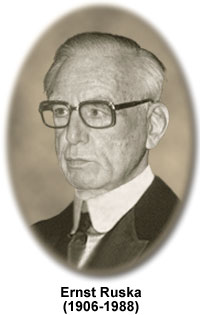Ernst Ruska – The Inventor of Electron Microscope

Although electron microscope was patented by Reinhold Rudenberg in 1931, the invention of the microscope which uses the electron beam rather than light to produce an image is traditionally credited to the German physicist Ernst Ruska. Ruska developed the first prototype of electron microscope together with Max Knoll in 1931 and two years later, he (alone) built the first electron microscope which gave a better resolution than the light microscope. In 1986, Ruska was awarded the Nobel Prize for his work in the field of electron optics as well as for construction of the first electron microscope.
Ernst Ruska was born on 25 December 1906 in Heidelberg, Germany to Professor Julius Ruska and his wife Elizabeth. After grammar school in Heidelberg, he continued education at the Technical College in Munich and later in Berlin where he got involved with high voltage and vacuum technology. At the same time, he worked on the development of high performance cathode ray oscilloscope with Dr Max Knoll and other students. Soon, however, Ruska became interested in electrons. His first scientific work in 1928-29 thus dealt with Hans Busch’s electron lens. And while he was researching Busch’s discovery, he realised that that an electron microscope with a 1,000 times shorter wavelengths from the ordinary light microscope could be used to get a better image with more details.
Together with Dr Max Knoll, Ruska continued to work on electron microscopy and in 1931, they have managed to develop the first prototype of electron microscope which is widely considered the world’s first electron microscope. However, it was not ready for practical use yet and did not produce a better image than the light microscope. Only the model that was built by Ruska in 1933 has proven his theory that a microscope which uses the electron beam rather than light can produce a better image.
In 1937, Ruska began working for Siemens and helped construct the first commercially available electron microscope in 1939. Shortly after he started to work for Siemens, he convinced the company to set up a visiting institute which enabled him and other scientists at Siemens to work with other German and foreign scientists. The visiting institute was led by Helmut Ruska, Ernst’s brother who together with other scientists worked on application of electron microscope.
Ruska continued to work for Siemens until 1955 when he became the director of the Institute for Electron Microscopy at the Fritz Haber Institute. Two years latter, he also started to work as a professor at the Technical University of Berlin. He stayed at both Institute for Electron Microscopy at the Fritz Haber Institute and Technical University of Berlin until 1974 when he retired.
The recognition for his role in electron microscopy came late. He was awarded one half of the Nobel Prize (the other half went to Gerd Binnig and Heinrich Rohrer) only in 1986, more than 50 years after he invented the first electron microscope and only two years before his death. Ruska died 1988 at the age of 82 in West Berlin.